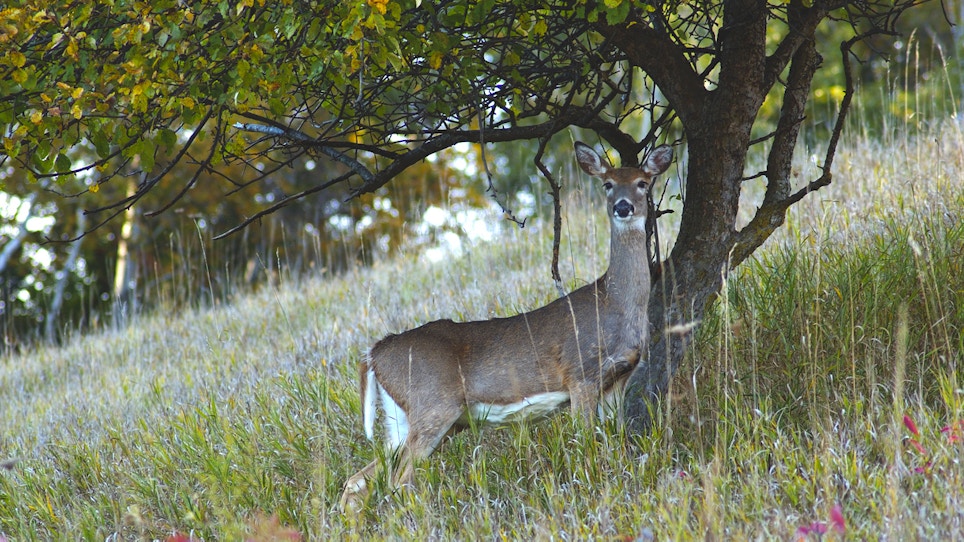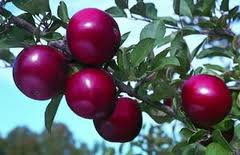Ever considered an alternative food plot that only requires one planting, produces for decades and requires only a little annual maintenance? If you like the sound of that, maybe it's time to plant fruit trees for deer.
Fruit trees not only serve as an attractant, but they also help hold more deer on your property and supply them with valuable high-energy calories and sugars, which help build critical fat reserves leading into winter. And If planted correctly, these trees also create hunting spots for bow season and early firearms season.
During the fall hunting season, Bob Wallace of Chestnut Hills Outdoors visited our central-Alabama hunting property and delivered 150 fruit and chestnut trees. Chestnut Hills Outdoors is a nursery in north-central Florida that specializes in growing and selling trees for wildlife. As Bob and I were busy planting trees, I was able to glean a lot of information about tree variety, maintenance, planting, etc.
In the video, Bob Wallace of Chestnut Hill Outdoors talks about the different varieties of fruit trees and why they benefit wildlife managers.
Variety
For our property we selected more late-dropping varieties of fruit trees to ensure they would be dropping their delicious mast during bow season — which in Alabama doesn’t start until October 15 — through early rifle season. However, climate plays a major role in which varieties you’ll be able to choose. Be sure to select from varieties adapted for your region of the country. Some fruit trees require more chill hours (amount of hours below 45 degrees) to ensure they grow properly and set a heavier fruit crop. Other varieties can’t handle extreme cold temperatures either. Hot, humid climates tend to be breeding grounds for fruit-tree diseases, requiring more disease-resistant trees. Below is a list of trees we selected for our hunting property.
Grafted Persimmons: The two varieties offered by Chestnut Hill are Deer Candy (early-dropping persimmon) and Deer Magnet (late dropping). The Deer Candy variety begins dropping fruit in August through October. The Deer Magnet holds its fruit until October and drops through November. Wallace suggests planting both varieties together for good pollination and extended fruit production from August through November. Both of these varieties are grafted females, which means every tree will produce fruit, unlike wild persimmons that can be male (non-producing trees) or female. These grafted varieties were selected because they are heavy producers, too. These trees grow well in USDA Plant Zones 5 through 9.
Apples: For our specific needs Wallace suggested we plant Arkansas Black and Winesap apples. Fire blight and other diseases are persistent in our hot, humid climate and both of these apple varieties are more disease resistant. Arkansas Black apples also ripen late into November and December, making them ideal for hunting orchards. Winesap is another late-dropping apple and is also a companion pollinator for Arkansas Black. There are many varieties of apples to choose from, so be sure to select varieties that grow well in your climate zone, are resistant to disease in your area and are companion pollinators with each other.
Related: Poor man’s food plot methods to try
Pears: Chestnut Hills offers a Thanksgiving Pear. It’s extremely resistant to disease and holds its fruit until Thanksgiving and early December. It’s a smaller pear that is highly attractive to deer and other wildlife. There are many pear varieties that drop at earlier dates and are suited for different climates.
Dunstan Chestnut: The Dunstan chestnut tree is a cross between the American chestnut and the Chinese chestnut, which makes it resistant to blight. It’s a heavy producing hard-mast tree with sweet tasting nuts loaded with carbohydrates and protein — unlike acorns, which consist mostly of oils and fats. Wallace recommends planting more Dunstan chestnuts than any other variety of fruit or nut trees because of its nutritional value for deer and other wildlife. We planted several large orchards of chestnuts throughout the property to provide tons of quality food and to hold deer on our land.
Location
Fruit and nut trees grow best in well-drained soils with a pH between 5.0 and 7.0. They can be planted in sandy, clay and loam soils. We pinpointed secluded ridgelines to plant the majority of our small hunting orchards. The hidden areas would hopefully allow deer to feel safe while feeding, thus encouraging daylight movement for hunting purposes. Ridgelines are also less susceptible to late frosts in the spring time when apple and pear trees are blooming and growing young fruit. Because colder air will pool in low-lying areas, these ridges might remain frost free during flower and fruit production.
Deer like to travel the edge of cover, so planting fruit and nut trees near timberlines or thickets is best. Be sure the trees are far enough out into the open to receive at least six hours of full sunlight each day. These trees need full sunlight to maximize fruit production. We planted a few of our orchards in wooded areas where deer regularly travel, so we had to go in with a chainsaw and cut down other trees to open the area up for sunlight.
Planting
Once a site is selected for a fruit-tree food plot, set the potted trees out where you want them to grow. Dunstan chestnut trees require a spacing of 30 to 40 feet, while fruit trees require about 20- to 30-feet spacing. Next, dig a hole twice as wide as the pot and just deep enough for the tree to be planted even with the ground level. Backfill the hole with the native dirt and use your shovel tip to pack the loose soil around the root ball. Continue backfilling until the hole is filled in. Then, pack the entire area with your boot ensuring there are no air pockets. Use the remaining dirt to build a berm around the root area to allow water to “pool” and soak in. Then, use a 5-gallon bucket to water each tree. It might only take half the bucket to fill up your berm with water.
While it’s not necessary, it’s highly recommended to install grow tubes around your young trees. Wallace recommends using a 4- to 5-foot-tall grow tube, which not only acts as a miniature greenhouse around the tree, but also helps water the tree each night when dew collects on the inside and falls to the root zone below. While grow tubes will help the young tree grow faster, it will also protect the tree from being damaged or killed by bucks rubbing their antlers on them or from other varmints gnawing on the tender bark.
Related: Here’s a year-round scouting camera plan
Maintenance
To keep maintenance down, select varieties suited for your climate and are resistant to diseases prevalent in your area. This will eliminate or cut down on the use of insecticides or fungicides sprays as well as ensure your trees maximize their production.
When trees are young, it’s important to keep weed competition down. Grasses and other weeds steal nutrients and water from young trees that don’t yet have a deep root system. You can install a black fabric weed mat at planting, or you can spray a non-selective herbicide like glyphosate to kill off weeds around the root zone when you’re using grow tubes. Be careful not to allow spray drift to get on the trunk as it can damage or kill young trees. The grow tube will greatly reduce this risk.
Annual fertilizing is necessary to get the most out of your fruit and nut trees. Don’t fertilize at planting, but add a balanced fertilizer such as 13-13-13 in the early spring at bud break and then again in June. This will ensure the tree’s roots and limbs grow more and will also supply the tree with needed nutrients for fruit production. Avoid spreading fertilizer within 5 inches of the tree’s trunk, but inside the canopy. Do not fertilize in the fall as it can promote limb growth just prior to winter, which will then be susceptible to winter injury and disease.
Be sure to choose trees that will grow best in your climate zone, and in three to five years your investment will begin dropping its delicious mast. However, once trees are mature, they will really start dropping an abundant crop in the fall that will attract and hold more wildlife on your property. Checkout Chestnut Hills Outdoors to see the many varieties of fruit and mast trees available for wildlife; www.chestnuthilloutdoors.com or call (855) 386-7826.








